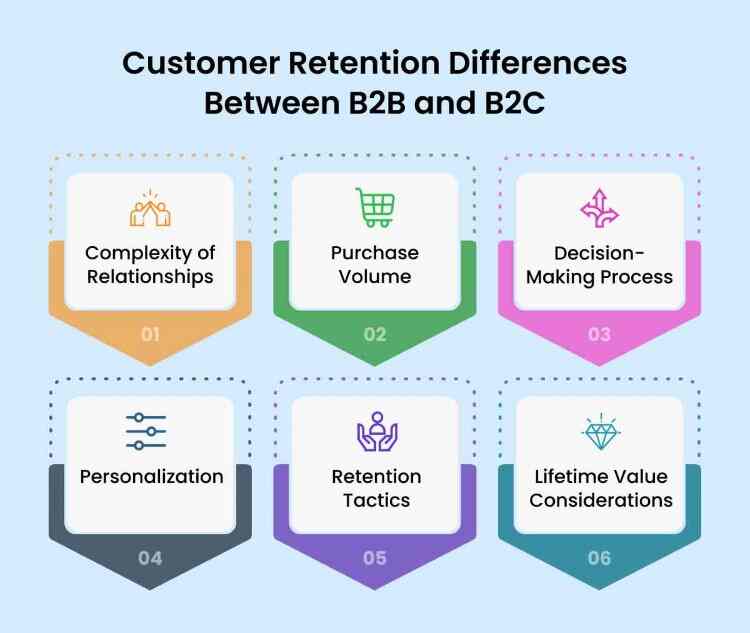In B2B business, attracting clients is just the first step. Keeping them is where the magic truly happens. Do you know customer retention is the secret sauce for sustainable success in the corporate realm?
This article breaks down the result-driven B2B customer retention strategies that will help you keep your customers coming back.
Importance of Customer Retention for B2B Business
It holds immense significance for B2B businesses. While the acquisition of new clients is undoubtedly essential, retaining existing clients is equally crucial, if not more so. In the B2B business landscape, clients often engage in long-term partnerships, and maintaining these relationships can lead to a steady and reliable revenue stream.
In many industries, the top five players on the market have an average customer retention rate of 94% according to Survey Sparrow.
By keeping your current clients satisfied, you not only reduce the costs associated with acquiring new ones but also tap into a consistent source of revenue. Moreover, loyal clients are more likely to provide referrals and testimonials, which can help in attracting new clients.
Additionally, through ongoing interactions and feedback, you gain valuable insights into your client’s evolving needs, enabling you to adapt your products or services to better serve them. Ultimately, customer retention fosters trust, brand loyalty, and sustained growth, making it a cornerstone of success for B2B businesses.
B2B Customer Retention Statistics
- Typical B2B customer retention rates range between 76% and 81%. (Forrester)
- According to a study by Bain & Company, a 5% increase in customer retention can lead to a 25–95% increase in profits for B2B companies.
- CAC in business has increased by 60% in 5 years. (Profit Well)
- Referred B2B customers have a 37% higher retention rate than acquired clients. (Think Impact)
- 71% of B2B customers are “psychologically and emotionally” detached from their suppliers. (Gallup)
- 71% of high-grown B2B brands have a clearly defined strategy for customer experience. (Forrester)
- 65% of B2B companies can successfully upsell to retained customers. (ThinkJar)
- Investing in customer experience reduces churn by 10-15% for B2B companies. (McKinsey)
Customer Retention Differences Between B2B and B2C
It differs significantly between B2B and B2C markets due to the distinct nature of their customer relationships and decision-making processes. Let’s take a closer look at customer retention differences.
1. Complexity of Relationships
- B2B: B2B relationships are often more complex, with longer sales cycles and multiple stakeholders. Building strong, lasting relationships is crucial, and retention efforts are typically more personalized.
- B2C: B2C relationships tend to be simpler, with shorter sales cycles and a focus on individual consumers. Retention strategies often involve broad marketing efforts and customer segmentation.
2. Purchase Volume
- B2B: It typically involves larger purchase volumes, making each client more valuable. Losing a B2B client can have a significant impact on revenue, emphasizing the importance of retention.
- B2C: While individual B2C transactions are smaller, B2C companies often have a larger customer base. Retention efforts aim to keep a high volume of individual customers coming back.
3. Decision-Making Process
- B2B: Its purchases often require consensus among multiple decision-makers. Effective retention strategies focus on maintaining relationships with all key stakeholders within the client’s organization.
- B2C: Its purchases are usually made by individual consumers, with fewer decision-makers. Retention strategies target the preferences and needs of the end consumer directly.
4. Personalization
- B2B: It is crucial in customer retention. It involves understanding each client’s unique needs, and industry challenges, and tailoring solutions accordingly.
- B2C: While personalization is also important in B2C, it often revolves around consumer preferences, purchase history, and behavior data to offer relevant products and recommendations.
5. Retention Tactics
- B2B: It may involve account management, ongoing support, customized solutions, long-term contracts, and exclusive benefits to maintain relationships.
- B2C: It often relies on loyalty programs, email marketing, discounts, and engaging content to keep individual customers interested.
6. Lifetime Value Considerations
- B2B: It often focuses on the long-term lifetime value of a client. Retaining a B2B client can lead to a consistent revenue stream over years or even decades.
- B2C: It may prioritize short-term purchases, but high retention can still significantly impact lifetime value, especially for brands with a strong consumer following.
How to Measure B2B Customer Retention Strategies?
Measuring the effectiveness of B2B customer retention strategies is essential to ensure that your efforts are yielding positive results and to identify areas for improvement.
Here are some key metrics and methods to measure the success of your B2B customer retention strategies:
- Customer Churn Rate: Calculate the percentage of customers you’ve lost over a specific time period. Churn rate = (Customers at the start – Customers at the end) / Customers at the start. A high churn rate indicates a need for improved retention strategies.
- Customer Lifetime Value (CLV): Determine the total revenue a customer brings over their entire relationship with your company. A rising CLV indicates successful retention efforts.
- Repeat Purchase Rate: Measure how often your customers make repeat purchases. This metric is particularly relevant for businesses with a subscription model.
- Net Promoter Score (NPS): NPS measures customer satisfaction and their likelihood to recommend your company to others. A high NPS suggests strong retention and positive word-of-mouth.
- Customer Satisfaction (CSAT) Score: Collect customer feedback through surveys to gauge satisfaction with your products or services. A high CSAT score indicates that customers are content with your offerings.
- Customer Retention Cost: Calculate the cost associated with retaining customers, including expenses related to loyalty programs, account management, and support. You should always ensure that your retention cost is lower than the value customers bring.
- Customer Engagement Metrics: Monitor customer interactions with your company, such as email open rates, click-through rates, and content consumption. You should keep one thing in mind higher engagement often leads to improved retention.
- Renewal and Upsell Rates: If your B2B business involves contracts or subscriptions, track renewal rates and the success of upsell or cross-sell offers to existing customers.
- Customer Feedback and Surveys: Gather customer feedback directly about their experience with your company. This qualitative data can provide insights into their needs and areas for improvement.
- Segmentation Analysis: Analyze the retention rates of different customer segments and identify which segments are most likely to churn and which are most loyal. This can help tailor strategies to specific groups.
- Customer Support Metrics: Assess the effectiveness and efficiency of your customer support by examining response times, issue resolution rates, and customer satisfaction with support interactions.
- Referral and Word-of-Mouth Tracking: Measure the number of customer referrals and monitor mentions of your brand in online and offline discussions. Unavoidably, satisfied customers are more likely to refer others.
- Customer Journey Mapping: Create customer journey maps to visualize the customer experience and identify touchpoints where improvements can enhance retention.
- Competitive Benchmarking: Compare your retention metrics to industry benchmarks and your competitors to understand your performance relative to the market.
- Predictive Analytics: Use predictive modeling and machine learning to forecast future retention rates and identify at-risk customers.
Regularly reviewing these metrics and conducting customer feedback analysis will provide valuable insights into the effectiveness of your B2B customer retention strategies. Adjust your strategy to address areas where retention can be improved and capitalize on what’s working well.
10 Result-driven B2B Customer Retention Strategies
In B2B relationships, customer retention is a critical component of long-term success. These 10 result-driven strategies are designed to keep your clients engaged, satisfied, and loyal.
1. Build Strong Relationships
Establishing and nurturing strong, personal relationships with your B2B clients is foundational. This involves understanding their unique needs, challenges, and goals. Regular communication, meetings, and open dialogue are essential. The goal is to make your clients feel valued and understood.
Pro Tip: Regularly touch base with your clients, not just when issues arise. Show genuine interest in their business and industry. Attend industry events together to strengthen the bond.
2. Deliver Exceptional Customer Service
Outstanding customer service is a cornerstone of retention. Be responsive, efficient, and effective in addressing client inquiries, issues, or concerns. Your support team should be knowledgeable and dedicated to ensuring your clients’ success.
Pro Tip: Invest in training your support team to handle complex B2B inquiries effectively. You should aim for quick response times and consistent follow-up to resolve issues promptly.
3. Customize Solutions
Tailoring your products or services to meet each client’s specific needs is a powerful retention strategy. Understand their pain points, industry nuances, and objectives. The more you can customize your offerings to solve their unique challenges, the more likely they are to remain loyal.
Pro Tip: Develop a deep understanding of each client’s business processes, goals, and pain points. You always have to consider creating a dedicated client success team to cater to their specific needs.
4. Continuous Improvement
B2B markets are dynamic, and it’s vital to stay ahead of the curve. Continually assess and enhance your offerings to remain competitive. Stay up-to-date with industry trends, technological advancements, and feedback from your clients to ensure that you’re delivering the best possible solutions.
Pro Tip: Regularly gather market intelligence and conduct competitor analyses to stay ahead of industry trends. Leverage agile development processes to adapt to changing needs swiftly.
5. Customer Feedback
Actively seek, collect, and act upon customer feedback. Utilize surveys, reviews, and direct communication to understand what your clients like and dislike about your offerings. Feedback is invaluable for refining your products and services.
Pro Tip: Use a combination of qualitative and quantitative feedback methods. Personalize your response to each client’s feedback to show that their opinions matter.
6. Retention Marketing
Implement marketing strategies specifically focused on retaining existing customers. This might include targeted email campaigns, personalized content, and special offers designed to keep clients engaged and informed about your latest solutions.
Pro Tip: Segment your client list based on their behaviors, preferences, and engagement levels. Tailor your marketing efforts to each segment to make your messages more relevant.
7. Value-added Content
Provide your clients with valuable content, such as industry insights, best practices, whitepapers, or webinars. This establishes your company as a trusted source of information and positions you as a partner in their success.
Pro Tip: Create content that directly addresses the challenges your clients face. Consider hosting webinars or providing industry-specific insights to showcase your expertise.
8. Reward Loyalty
You should always create loyalty programs or reward systems for long-term clients. Offer discounts, exclusive access to new features, or special treatment. Loyalty rewards encourage clients to remain engaged and invested in your services.
Pro Tip: Offer tiered loyalty rewards to encourage clients to reach higher levels, providing an extra incentive to stay with your company for the long term.
9. Proactive Problem-Solving
Anticipate issues and challenges that your clients may face and proactively address them. If a problem arises, work quickly to resolve it to the satisfaction of your client. This proactive approach can prevent dissatisfaction and enhance loyalty.
Pro Tip: Anticipate potential issues and communicate your proactive approach to clients. You should share solutions or workarounds before they encounter problems, showing that you’re dedicated to their success.
10. Long-term Contracts
Don’t forget to consider offering long-term contracts with pricing incentives. Long-term commitments can lock in your customers, providing them with a sense of predictability and stability. This reduces the likelihood of them exploring alternative solutions.
Pro Tip: Be transparent about the benefits of long-term contracts, such as cost savings and predictability. Make it a win-win by offering flexibility and adaptability within the contract terms.
These strategies work together to create a comprehensive B2B customer retention approach. By building strong relationships, delivering exceptional service, and continually improving your offerings, you can foster loyalty and ensure that your clients choose to stay with your company for the long haul.
Conclusion
In the B2B business world, relationships are the currency and loyalty is the gold standard, these result-driven customer retention strategies are your secret weapon. Remember, it’s not just about acquiring clients; it’s about keeping them delighted and dedicated for the long run.
So, go ahead and apply these strategies to fuel your B2B success story, because in the world of business, the real magic happens when you keep the spotlight on your valued clients. Cheers to your thriving, enduring relationships!








